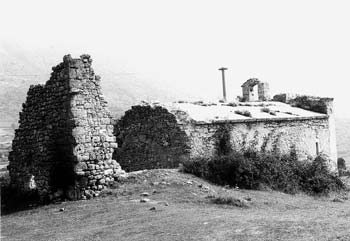
We came across these ruins while taking a walk in the mountains with our children and their families: the little church was used as a stable, the roof was caving in and the rectory was totally destroyed. Fascinated by the beauty of the place, we decided to do something to restore the building to its dignity of the House of God.
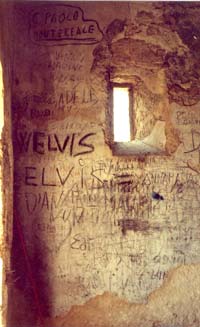 We talked about it to Father Ruggero Gallo, the pastor of Camarda, the jurisdiction of the church of San Pietro della Genca. He told us that he wasn’t interested in the matter and that he was already too busy looking after his parish church. We talked about it to Father Ruggero Gallo, the pastor of Camarda, the jurisdiction of the church of San Pietro della Genca. He told us that he wasn’t interested in the matter and that he was already too busy looking after his parish church.
In the diocesan administration they told us that there weren’t any pastoral interests in that totally uninhabited area and that we had to ask the Monuments and Fine Arts Department.
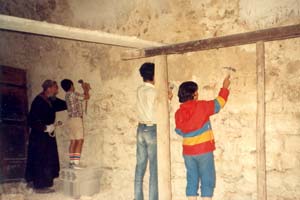 The person in charge of this Department told us there weren’t any funds for that construction, which was considered as lacking any artistic interest. The person in charge of this Department told us there weren’t any funds for that construction, which was considered as lacking any artistic interest.
We then decided to contract the work ourselves because it wasn’t right to leave the house of God in those conditions and, equipped with wheelbarrows and picks, we started the restoration.
It was the summer job of 1984: the master builder was Giovanni Antonucci, the labourers were Father Andrea D’Ascanio and the group of children with their parents. 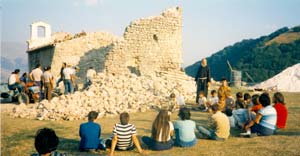 Everybody worked, from the oldest to the youngest, with their best efforts and, at the end of a day’s work, prayer gave meaning to every effort. Very precious assistance was given by the brothers Vincenzo and Massimo Pulsoni from Camarda; the contribution made by Edmondo and Livio Ruggeri from Rome was decisive for the reconstruction of the roof. When the church was re-consecrated on 24 October 1984, on its background we placed a big oval portraying the Father who welcomes the Son after His victorious earthly life. We brought to this church all those who came to visit us in Aquila: one of the main goals of the Armata Bianca is to make known to children and adults the true Face of God, the Father of tenderness and mercy. Everybody worked, from the oldest to the youngest, with their best efforts and, at the end of a day’s work, prayer gave meaning to every effort. Very precious assistance was given by the brothers Vincenzo and Massimo Pulsoni from Camarda; the contribution made by Edmondo and Livio Ruggeri from Rome was decisive for the reconstruction of the roof. When the church was re-consecrated on 24 October 1984, on its background we placed a big oval portraying the Father who welcomes the Son after His victorious earthly life. We brought to this church all those who came to visit us in Aquila: one of the main goals of the Armata Bianca is to make known to children and adults the true Face of God, the Father of tenderness and mercy.
Our intention was to consecrate a place to the Father where He could encounter His children in the beautiful setting of the massif of the Abruzzi..
At the end of the restoration the church was handed over.
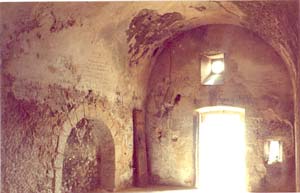
On 20 July 1995 Dr. Giulio Di Nardo, as secretary of the Movement, wrote the following letter to Msgr. Peressin:
Your Excellency,
We ask you to renew our permission to use the church of San Pietro della Genca, which was restored in due time by our association “Armata Bianca”, for another five years.
We will take care of completing the work of restoration of the small rectory.
May you bless us.
Giulio Di Nardo
On behalf of the Armata Bianca
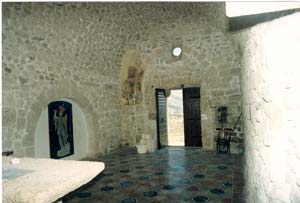
On 24 July 1995, Msgr. Peressin wrote at the bottom of the letter: “The Archbishop agrees” and the Vicar, Father Demetrio Gianfrancesco, added, “The pastor of Camarda, whom I talked to on the phone on the evening of 24 July, agrees”.
Therefore, we continued the restoration of the small rectory, which was then completed by the Monuments and Fine Arts Department, following our pressure.
John Paul II and the little church of San Pietro della Genca
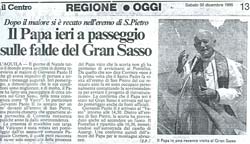 Knowing the love that His Holiness John Paul II had for the mountains of the Gran Sasso and for children, we sent him – through Card. Andrea Deskur, who always kept him informed of the initiatives of the Armata Bianca – a formal invitation to visit this church during one of his excursions to the Gran Sasso. Knowing the love that His Holiness John Paul II had for the mountains of the Gran Sasso and for children, we sent him – through Card. Andrea Deskur, who always kept him informed of the initiatives of the Armata Bianca – a formal invitation to visit this church during one of his excursions to the Gran Sasso.
In the invitation we enclosed a photo album and the key to the little church. We wanted him to be welcomed by many children, just as when he came to Aquila in August of 1980 and like the audience at the Sala Nervi on 27 May 1989. Here is a copy of the invitation:
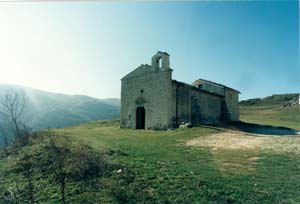 ARMATA BIANCA ARMATA BIANCA
Aquila, 23 September 1996
Dear Father,
We are sending you an album with the photos of the work we have done to restore a church at the foot of the Gran Sasso, where you come once in a while. It is called San Pietro, just like where you live, and it is the spiritual heart of the Armata Bianca.
This little church was reduced to ruins, and it became a stable where shepherds kept their animals. The interior was all covered in awful writings and it was blackened by smoke because the shepherds used to light a fire to cook roasts. However, the statue of St. Peter was left because, since it was made of concrete and was very heavy, nobody had taken it.
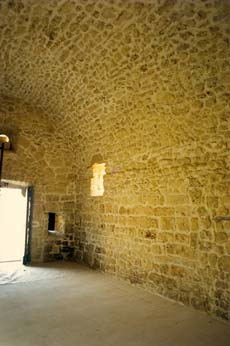 We went to that area in the summer of 1984 to make an excursion and we were so sorry to see in what conditions the church was reduced. We children promised to work the whole summer and the following day, with Father Andrea as our leader, we started with a shovel and an old wheelbarrow. Then our parents came, and the Church started to take on a new aspect. We went to that area in the summer of 1984 to make an excursion and we were so sorry to see in what conditions the church was reduced. We children promised to work the whole summer and the following day, with Father Andrea as our leader, we started with a shovel and an old wheelbarrow. Then our parents came, and the Church started to take on a new aspect.
Every day we recited the Rosary and we offered our work so that from the ruins of the old Church a new and more marvellous one would emerge, which would mark the triumph of the Immaculate Heart of Mary: not only for the renewal of a little Church in the mountains, but of the whole holy Church of God.
Some of us met you when you came to Aquila on 30 August 1980. On that occasion, together withmore than 4,000 children gathered in the stadium, we awaited you by reciting the entire Rosary so that in Poland there would be an agreement between the Government and Solidarnosc: for your coming we wanted to give you the gift of Peace in your land. Our Lady heard us: the agreement, after several months of fighting, was signed that very afternoon.
Then 400 of us from Aquila came to visit you in Rome. We returned to the Sala Nervi in 1989, this time we numbered 10,000, from many parts of Italy.
Our beloved Father, you are always among “grown-ups”, in your “big” St. Peter’s. Why don’t you come to pray and play with us “little ones” in our “little” St. Peter’s?
We children of the Armata Bianca – today there are so many of us in the world – recite the Rosary for you every day and we offer our lives for you, “ready to accept everything the Lord wishes to send us” so that you may win the great battle of Mary.
Will you come? We look forward to your coming with so much love and we are sending you the key.
 Bless us always and embrace us with all your Love. Bless us always and embrace us with all your Love.
The children of the Armata Bianca of yesterday and today
Upon agreement by telephone a Monsignor came on the spot to examine the situation and celebrate Holy Mass; he told us that His Holiness accepted the invitation and that he would come to see “the little St. Peter’s church of Aquila” but that he didn’t want any publicity for what would be a strictly private visit. We respected His wishes.
However, when the news of his visit got out, there was a lot of hype and – as often happens – political and parochial representatives of the small community of Camarda remembered the church of St. Peter until then forgotten and reduced to a stable and claimed responsibility for its reconstruction and the right to its exclusive management.
Perhaps it was in the name of that “right” that the locks were arbitrarily changed and suddenly from the church disappeared the images of the Trinity and St. Michael and the memorial stone which recalled the restoration work done by the Armata Bianca. On 7 May 1997 a report was made to the police for this desecration, however there followed only silence and the laying of a “commemorative stone” of the restoration work done by the citizens of Camarda and the Monuments and Fine Arts Department, completely forgetting the work of the Armata Bianca.
Once again, nothing new under the sun….
The story continues…
18 May 2005. the “Wojtyla Path” was officially inaugurated, a mule track which from the church of San Pietro della Genca (1166 m asl.) climbs up to the rocky tower which local alpinists called the “Gendarme”, along the crest which connects the peak of Malecoste with Cefalone Peak. The peak was renamed “John Paul II Peak” (2424m), the name of another “rock”, the one of the Vicar of Christ who led the world to “turn his eyes to the heavens, toward the summit of grace and glory”.
At the top there is an iron cross with the image of Pope Wojtyla, in the middle, and on the arms those of the four patron saints of the city of Aquila: St. Massimo, St. Bernardine of Siena, St. Equizio and St. Peter the hermit, better known as Pope Celestine V.
We are happy that other initiatives have followed ours, but we wonder why the image of the Father was torn up, since it gave the little church of St. Peter a prophetic dimension: it was the first church in the world dedicated to God the Father.
|


 We talked about it to Father Ruggero Gallo, the pastor of Camarda, the jurisdiction of the church of San Pietro della Genca. He told us that he wasn’t interested in the matter and that he was already too busy looking after his parish church.
We talked about it to Father Ruggero Gallo, the pastor of Camarda, the jurisdiction of the church of San Pietro della Genca. He told us that he wasn’t interested in the matter and that he was already too busy looking after his parish church. The person in charge of this Department told us there weren’t any funds for that construction, which was considered as lacking any artistic interest.
The person in charge of this Department told us there weren’t any funds for that construction, which was considered as lacking any artistic interest. Everybody worked, from the oldest to the youngest, with their best efforts and, at the end of a day’s work, prayer gave meaning to every effort. Very precious assistance was given by the brothers Vincenzo and Massimo Pulsoni from Camarda; the contribution made by Edmondo and Livio Ruggeri from Rome was decisive for the reconstruction of the roof. When the church was re-consecrated on 24 October 1984, on its background we placed a big oval portraying the Father who welcomes the Son after His victorious earthly life. We brought to this church all those who came to visit us in Aquila: one of the main goals of the Armata Bianca is to make known to children and adults the true Face of God, the Father of tenderness and mercy.
Everybody worked, from the oldest to the youngest, with their best efforts and, at the end of a day’s work, prayer gave meaning to every effort. Very precious assistance was given by the brothers Vincenzo and Massimo Pulsoni from Camarda; the contribution made by Edmondo and Livio Ruggeri from Rome was decisive for the reconstruction of the roof. When the church was re-consecrated on 24 October 1984, on its background we placed a big oval portraying the Father who welcomes the Son after His victorious earthly life. We brought to this church all those who came to visit us in Aquila: one of the main goals of the Armata Bianca is to make known to children and adults the true Face of God, the Father of tenderness and mercy.

 Knowing the love that His Holiness John Paul II had for the mountains of the Gran Sasso and for children, we sent him – through Card. Andrea Deskur, who always kept him informed of the initiatives of the Armata Bianca – a formal invitation to visit this church during one of his excursions to the Gran Sasso.
Knowing the love that His Holiness John Paul II had for the mountains of the Gran Sasso and for children, we sent him – through Card. Andrea Deskur, who always kept him informed of the initiatives of the Armata Bianca – a formal invitation to visit this church during one of his excursions to the Gran Sasso. ARMATA BIANCA
ARMATA BIANCA We went to that area in the summer of 1984 to make an excursion and we were so sorry to see in what conditions the church was reduced. We children promised to work the whole summer and the following day, with Father Andrea as our leader, we started with a shovel and an old wheelbarrow. Then our parents came, and the Church started to take on a new aspect.
We went to that area in the summer of 1984 to make an excursion and we were so sorry to see in what conditions the church was reduced. We children promised to work the whole summer and the following day, with Father Andrea as our leader, we started with a shovel and an old wheelbarrow. Then our parents came, and the Church started to take on a new aspect.  Bless us always and embrace us with all your Love.
Bless us always and embrace us with all your Love.